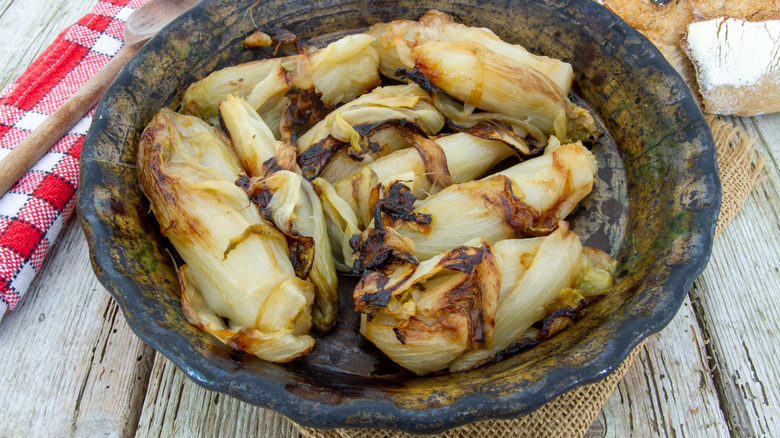What You Need To Know About Cooking With Endives
You might see the terms "frisée," "escarole," or "endive" in the culinary world. Moreover, in rare cases, you may find the word "chicory" on a menu. Despite not being precisely synonymous, these names are often used interchangeably to label the same kinds of leafy vegetables.
Still, there are really only three types of endive — Belgian, curly, and broad-leafed – and they're all part of the chicory family. Chicory root is often used as an alternative for coffee, but the leafy part of the plant (the focus here) is a cold-season crop, generally at its freshest during the autumn and winter months.
Additionally, endives are frequently lumped in with other greens and are arguably overutilized in dishes like Belgian endive salad. That's not to say they're not delicious in a salad, but they're more versatile and their uses can go way beyond that. For instance, Belgian endives are more durable than their peers due to their iconic form — they're more compact and slightly tube-shaped. As a result, they're perfect for grilling or baking because they tend to hold up and still retain their appearance after the cooking process.
Moreover, as Chef José Andrés explained to The Wall Street Journal, endive leaves work wonderfully in cold-plated appetizers because of their "boat-like shape," which can carry almost anything you may think of. So, when it comes to tapas, get as inventive as you want. However, that doesn't mean you should leave escarole and frisée on the sidelines, either.
How to cook the different varieties
There are several types of endives to choose from, so things can get a little convoluted. For example, Belgian endives aren't technically endives; they're a category of radicchio, which is chicory but not exactly a part of the endive classification. Still, this little tidbit is good to know, since Belgian endives make a perfect substitute in this radicchio risotto with dried plums, especially if you want a milder, less bitter alternative. Just try and remember the core is firm and fibrous, so it's usually removed before eating.
Furthermore, escarole and frisée differ in appearance and flavor from the more bitter Belgian variety. For instance, frisée consists of bristly loose-leaf greens. The inner leaves are a perfect addition to salads because of their tenderness, while the outer leaves are much more resilient and remarkable for sautéing and other heated applications.
On the other hand, escarole consists of crinkled open leaves but is more similar to a head of butter lettuce in presentation. Incidentally, escarole also has a more subtle taste than the others and makes a pleasing inclusion in soups and pasta. Also, escarole is comparable to frisée, in that its texture is similar when it comes to the inner and outer leaves. So, act accordingly to get the most out of this produce.
How to pick the best endives and store them
Now, with that settled, let's pick the freshest endives you can find. Belgian endives, for example, often have a white stalk with either light green or magenta-tinged ends. The leaves should be closely grouped, and the heads must be firm and heavy. Try to bypass any with wilted, brown, dry, or slimy leaves.
A good way to store Belgian and curly endives is to wrap them in a damp paper towel and place them in a vented plastic bag. This is to discourage wilting by providing a barrier from excess light — Belgian endives, for instance, are blanch-grown, a horticultural technique used to inhibit photosynthesis, which will further damage the produce. Escarole, on the other hand, must be covered with a dry towel to prevent excess moisture before storing it in a refrigerated bag.
Regardless, what makes endives stand out amongst greens is their bitter flavor, which also carries a slight sweetness that pairs well with the crispness of their leaves. Moreover, they balance nicely with sweet dressings and savory components that need a little sharpness for a more well-rounded profile. Nonetheless, before diving into the world of endives, be prepared to welcome the bite. Ultimately, you can't go wrong putting them in tarts, hors d'oeuvres, soups, pasta, braised or sautéd dishes, and the ever-favorite salad.


